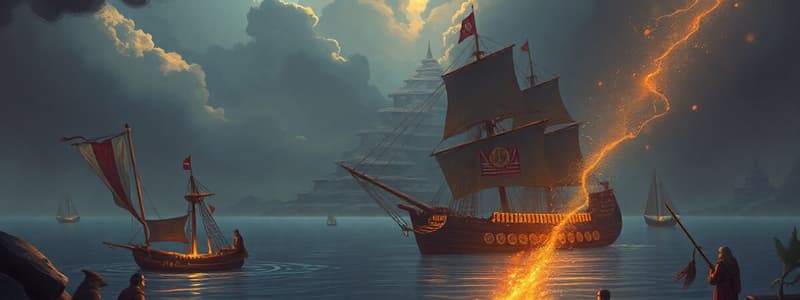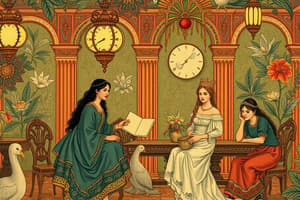Podcast
Questions and Answers
Which of the following best describes the significance of historiography?
Which of the following best describes the significance of historiography?
- It helps us understand how historical narratives are constructed and can evolve. (correct)
- It focuses solely on verifying the accuracy of historical dates and names.
- It promotes a singular, universally accepted interpretation of historical events.
- It provides a definitive and unchanging account of past events.
The Columbian Exchange primarily involved the exchange of goods and ideas between Asia and the Americas.
The Columbian Exchange primarily involved the exchange of goods and ideas between Asia and the Americas.
False (B)
Describe one significant impact of the Columbian Exchange on European society.
Describe one significant impact of the Columbian Exchange on European society.
The introduction of new crops such as potatoes and maize transformed European agriculture and diets, contributing to population growth and economic changes.
The transatlantic trading network between Europe, Africa, and the Americas, active from the 16th to the 19th century, is known as the ______ Trade System.
The transatlantic trading network between Europe, Africa, and the Americas, active from the 16th to the 19th century, is known as the ______ Trade System.
Match the following regions with their primary role in the Triangle Trade System:
Match the following regions with their primary role in the Triangle Trade System:
What is the most accurate definition of Syncretism?
What is the most accurate definition of Syncretism?
Historiography is solely concerned with establishing a definitive record of past events without considering the historian's perspective or biases.
Historiography is solely concerned with establishing a definitive record of past events without considering the historian's perspective or biases.
Explain how the effects of cultural syncretism are visible in the cultural practices of African Americans.
Explain how the effects of cultural syncretism are visible in the cultural practices of African Americans.
Which of the following best describes the significance of syncretism in a historical context?
Which of the following best describes the significance of syncretism in a historical context?
The “Gunpowder Empires” (Ottoman, Safavid, and Mughal) relied solely on gunpowder technology for their military successes, with no significant contributions from administrative or economic strategies.
The “Gunpowder Empires” (Ottoman, Safavid, and Mughal) relied solely on gunpowder technology for their military successes, with no significant contributions from administrative or economic strategies.
What was the primary goal of Akbar in founding Din-i Ilahi, and why did it ultimately fail?
What was the primary goal of Akbar in founding Din-i Ilahi, and why did it ultimately fail?
In the Chinese Social Pyramid during the Ming and Qing dynasties, __________ were ranked low despite their wealth due to Confucian values that prioritized agricultural and scholarly pursuits.
In the Chinese Social Pyramid during the Ming and Qing dynasties, __________ were ranked low despite their wealth due to Confucian values that prioritized agricultural and scholarly pursuits.
Match the following events/policies with their primary consequences:
Match the following events/policies with their primary consequences:
What critical advantage did Korea, supported by the Ming Dynasty, leverage to effectively repel the Imjin War invasion led by Toyotomi Hideyoshi?
What critical advantage did Korea, supported by the Ming Dynasty, leverage to effectively repel the Imjin War invasion led by Toyotomi Hideyoshi?
The 'Gun Hunt' policy in Tokugawa Japan led to a more egalitarian society by distributing weapons more evenly among the population.
The 'Gun Hunt' policy in Tokugawa Japan led to a more egalitarian society by distributing weapons more evenly among the population.
Explain how the invention of the printing press altered the landscape of European intellectual and religious life.
Explain how the invention of the printing press altered the landscape of European intellectual and religious life.
The __________ was an intellectual movement that emphasized reason, individual rights, and scientific inquiry. Thinkers like John Locke, Voltaire, and Montesquieu challenged traditional authority, advocating for democracy, secularism, and human rights.
The __________ was an intellectual movement that emphasized reason, individual rights, and scientific inquiry. Thinkers like John Locke, Voltaire, and Montesquieu challenged traditional authority, advocating for democracy, secularism, and human rights.
Which statement accurately reflects the long-term impact of the Enlightenment on global political structures?
Which statement accurately reflects the long-term impact of the Enlightenment on global political structures?
Flashcards
Historiography
Historiography
The study of how history is written, including historians' methods and biases.
Changing Historical Interpretations
Changing Historical Interpretations
How interpretations of historical events change over time due to new evidence or cultural shifts.
Columbian Exchange
Columbian Exchange
The transfer of plants, animals, people, diseases, and ideas between the Americas, Europe, and Africa after 1492.
New World crops in Europe
New World crops in Europe
Signup and view all the flashcards
Impact of diseases in the Americas
Impact of diseases in the Americas
Signup and view all the flashcards
Triangle Trade System
Triangle Trade System
Signup and view all the flashcards
Middle Passage
Middle Passage
Signup and view all the flashcards
Syncretism
Syncretism
Signup and view all the flashcards
Gunpowder Empires
Gunpowder Empires
Signup and view all the flashcards
Din-i Ilahi
Din-i Ilahi
Signup and view all the flashcards
Chinese Social Pyramid
Chinese Social Pyramid
Signup and view all the flashcards
Imjin War
Imjin War
Signup and view all the flashcards
Gun Hunt
Gun Hunt
Signup and view all the flashcards
Printing Press
Printing Press
Signup and view all the flashcards
Enlightenment
Enlightenment
Signup and view all the flashcards
Study Notes
- Historiography examines how history is written, including historian's methods, perspectives, and biases.
- It highlights how interpretations of historical events change due to new evidence or cultural shifts.
- Early European historians viewed exploration heroically, but modern views critique it as conquest and exploitation.
- This field helps reveal biases and evolving interpretations of history.
The Columbian Exchange
- This refers to the transfer of plants, animals, people, and diseases between the Americas, Europe, and Africa after 1492.
- Crops like potatoes and maize were introduced to Europe.
- Old World diseases such as smallpox spread in the Americas.
- Enslaved people were transferred from Africa to the Americas.
- It transformed global agriculture, economies, and demographics.
- This exchange contributed to European dominance and the decline of American indigenous societies.
Triangle Trade System
- This was a three-way transatlantic trading network between Europe, Africa, and the Americas (16th-19th century).
- European merchants traded manufactured goods for enslaved people in Africa
- Enslaved people were shipped to the Americas via the "Middle Passage".
- Raw materials from the Americas were sent to Europe
- It fueled European economies and entrenched the Atlantic slave trade.
- It devastated African societies and shaped the economic structure of the Americas.
Syncretism
- This is the combination of different cultural traditions into a new hybrid identity or culture.
- African Americans developed a unique cultural identity blending African and American influences.
- It shows how cultures interact and adapt, creating unique social identities.
"Gunpowder Empires"
- This term refers to the Ottoman, Safavid, and Mughal empires (15th-18th centuries).
- These empires used gunpowder-based military technology.
- They centralized power through advanced firearms, cannons, and administration.
- The Ottoman Empire captured Constantinople in 1453 using gunpowder weaponry.
- Military advancements contributed to state-building and reshaped Afro-Eurasia.
Din-i Ilahi
- It was a syncretic religious movement created by Mughal Emperor Akbar in the late 16th century.
- It combined elements of Islam, Hinduism, and other religions.
- Akbar aimed to unify his religiously diverse empire.
- The movement failed to gain widespread acceptance.
- Din-i Ilahi is an example of religious tolerance and imperial strategies for unification.
Chinese Social Pyramid
- During the Ming and Qing dynasties, the Emperor was at the top
- Scholars and bureaucrats were next, with peasants, artisans, and merchants at the bottom.
- Merchants ranked low despite wealth due to Confucian values.
- It reinforced Confucian ideology, maintained social order, and influenced governance for centuries.
Imjin War
- The Imjin War took place between 1592-1598
- Japan, under Toyotomi Hideyoshi, invaded Korea to conquer Ming China.
- Korea, supported by the Ming Dynasty, repelled the invasion.
- Naval tactics led by Admiral Yi Sun-sin were instrumental in the victory
- The war devastated Korea, weakened the Ming Dynasty, and led to Japan's isolationism.
- It shaped East-Asian geopolitics and demonstrated naval power's importance.
Gun Hunt
- It refers to Tokugawa Japan's policy of weapon control in the 16th and 17th centuries.
- The aim was to disarm peasants and centralize power under the shogunate.
- The government confiscated firearms and restricted sword ownership.
- It established the Tokugawa Shogunate's stability (Edo period).
- It contributed to Japan's military weakness compared to Western powers.
Printing Press
- Johannes Gutenberg invented the printing press in the mid-15th century.
- It revolutionized communication by making books more accessible.
- It spread Renaissance ideas and fueled the Protestant Reformation.
- It accelerated scientific progress.
- The printing press democratized knowledge and weakened the Catholic Church's information control.
- It contributed to the rise of literacy and education in Europe.
Enlightenment
- It was an intellectual movement of the 17th and 18th centuries.
- The Enlightenment emphasized reason, individual rights, and scientific inquiry.
- Thinkers such as John Locke, Voltaire, and Montesquieu challenged traditional authority.
- They advocated for democracy, secularism, and human rights.
- It influenced the American and French Revolutions.
- The Enlightenment shaped modern political and philosophical thought.
Studying That Suits You
Use AI to generate personalized quizzes and flashcards to suit your learning preferences.




